-

-
Courses
Find courses by:
Collections
Cross-Disciplinary Topic Lists
- About
- Donate
- Featured Sites
This is an archived course. A more recent version may be available at ocw.mit.edu.
Each character entry below contains a ≤1 MB QuickTime movie of the character being painted with a brush, created by Prof. Saeko Komori of Chubu University. Please see the JP Net Kanji Project for more details.
In the following definitions, on (Chinese-based) readings are represented by katakana, and by capital romaji letters; kun (native Japanese-based) readings are represented by hiragana, and by lower-case romaji letters. This is a common dictionary convention, and does not have any bearing on meaning.
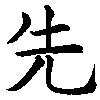
Stroke order: (MOV)
Printed form: 先
Readings: さき/セン saki/SEN
Meaning: ahead; previous
Mnemonic:
A picture of a leader holding a flag and walking with big steps.
Usage examples:
この先 (このさき) ahead of this
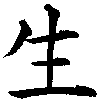
Stroke order: (MOV)
Printed form: 生
Readings: セイ SEE
Meaning: birth; life
Mnemonic:
Young grass is sprouting from the ground.
Usage examples:
先生 (せんせい) teacher
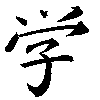
Stroke order: (MOV)
Printed form: 学
Readings: ガク GAKU
Meaning: learning; study
Mnemonic:
A smart child 子 wearing a fancy hat.
Usage examples:
学生 (がくせい) student
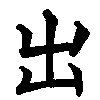
Stroke order: (MOV)
Printed form: 出
Readings: で/で- de/de-
Meaning: to go (come) out; leave
Mnemonic:
A sketch of plants coming out from the ground.
Usage examples:
出口 (でぐち) exit
出かけます (でかけます) [I] (will) go out
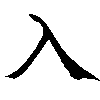
Stroke order: (MOV)
Printed form: 入
Readings: い- (i-) - enter
はい(る) (hairu) - to go in
Mnemonic:
A course of a river entering into the ocean.
Usage examples:
入り口 (いりぐち) entrance
入ります (はいります) (will) go in

Stroke order: (MOV)
Printed form: 口
Readings: くち/ぐち kuti/guti
Meaning: mouth
Mnemonic:
A wide-opened mouth.
Usage examples:
入口 (いりぐち) entrance
山口 (やまぐち) (Mr./Ms.) Yamaguchi
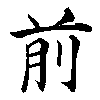
Stroke order: (MOV)
Printed form: 前
Readings: まえ mae
Meaning: front; before
Mnemonic:
A lord wearing a helmet with horns leading his warriors under the moon 月 carrying swords.
Usage examples:
店の前 (みせのまえ) in front of a store
前の入り口 (まえのいりぐち) front entrance
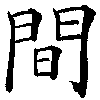
Stroke order: (MOV)
Printed form: 間
Readings: あいだ (aida) - (space) between
カン (KAN) - interval; space; between; (as suffix) between, among
Mnemonic:
The sun 日 shining into a space between double paneled doors 門.
Usage examples:
電話と出口の間 (でんわとでぐちのあいだ) between a telephone and an exit
一時間 (いちじかん) one hour
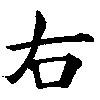
Stroke order: (MOV)
Printed form: 右
Readings: みぎ migi
Meaning: right
Mnemonic:
A hand ナ which brings food to the mouth 口.
Usage examples:
右 (みぎ) right
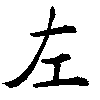
Stroke order: (MOV)
Printed form: 左
Readings: ひだり hidari
Meaning: left
Mnemonic:
A hand ナ to hold a ruler エ.
Usage examples:
左 (ひだり) left

Stroke order: (MOV)
Printed form: 店
Readings: みせ mise
Meaning: shop; store
Mnemonic:
A store with a curtain in front and a fortune-teller 占 inside.
Usage examples:
店 (みせ) a store
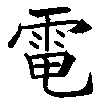
Stroke order: (MOV)
Printed form: 電
Readings: デン DEN
Meaning: electricity
Mnemonic:
When it rains 雨 hard, lightning (a dragon 竜 in the sky) may strike.
Usage examples:
電車 (でんしゃ) electric train
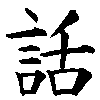
Stroke order: (MOV)
Printed form: 話
Readings: ワ WA
Meaning: talk; speech
Mnemonic:
The radical for "words" 言 and "a tongue" 舌 which produces a thousand 千 words.
Usage examples:
電話 (でんわ) telephone

Stroke order: (MOV)
Printed form: 方
Readings: ホウ (HOO) - direction; side
かた (kata) - direction, person, method
Mnemonic:
万 means "all possible directions" and the top stroke determines one designated direction.
Usage examples:
右の方 (みぎのほう) the right-hand side
こちらの方 (こちらのほう) this direction
この方 (このかた) this person
あの方 (あのかた) that person
[Quizzes (JavaScript required): Meaning (15 questions) | Reading (13 questions) | Character Recognition (13 questions)]